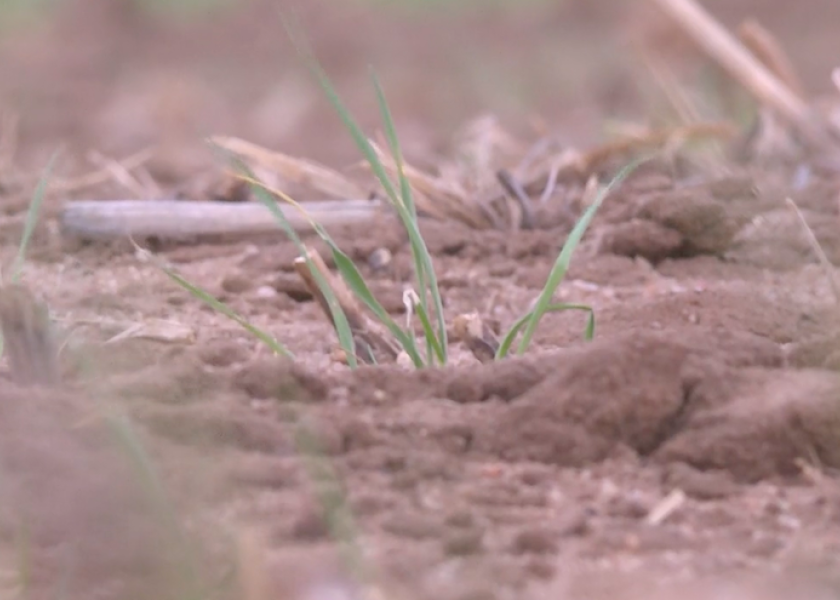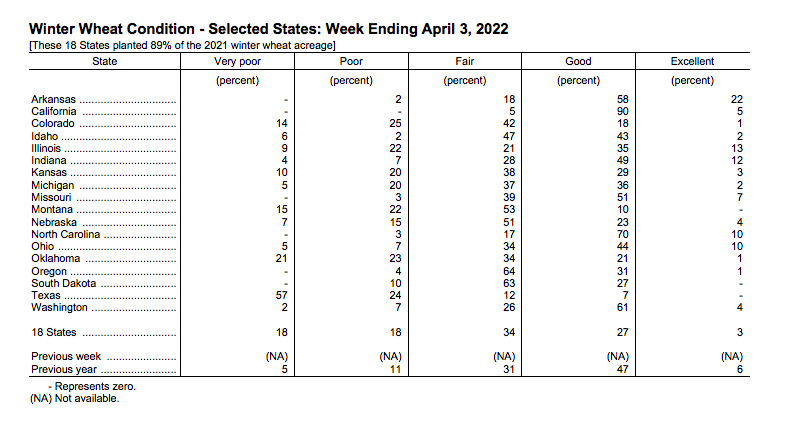USDA's First Crop Progress Report of the Year Reveals Winter Wheat Worse Than Expected

USDA's first Crop Progress Report of the year showed 2% of the corn crop is planted, right on par with average. But the stat that drew the most attention was USDA's look at winter wheat conditions, showing only 27% of the nation's winter wheat crop is rated "good," far below the trade's expectations.
USDA shows only 30% of the U.S. winter wheat crop is rated good to excellent, with 36% rated very poor to poor. Compare that to a year ago when 53% of the crop was in good to excellent condition, with only 16% rated poor to very poor.
The numbers reflect what growers in the Plains and Texas already know-- the battle against drought is proving brutal in winter wheat.
Other state by state findings include:
- Texas: 81% poor to very poor; 57% rated very poor
- Colorado: 39% rated poor to very poor
- Oklahoma: 44% rated poor to very poor
- Kansas: 30% rated poor to very poor.

Brian Brooks farms in the far southeast corner of Colorado, and he says even in an area used to arid climate, this winter has been nothing short of brutal.
"You can see the wheat is trying and barely hanging on the roots,” says Brooks, a farmer in Baca County, Colo. “You can just tell how abusive this winter has been.”
With wind events north of 50 mph, the wind has even robbed area farmers of their crop. He thinks 80% of the dryland wheat in this area may not make it this year, with some acres of fall planted wheat still barren. That’s as only a trace of moisture has materialized since fall. It’s been too dry for many wheat fields to even sprout.
Brooks is one of many farmers facing a bleak picture in the Southern High Plains, as the lack of moisture this winter has been historic.
“If you look at the November to February period, it’s the second driest on record behind only that of 2017/2018,” says Brad Rippey, USDA meteorologist. “It's just another year that we've experienced in a string of very difficult years going back to the mid-1990s.”
University of Missouri economist Ben Brown says the true picture of winter wheat conditions is just coming to fruition as the crop breaks dormancy and farmers can truly asses the damage caused by drought. And he says some tough decisions will be made in the coming weeks.
"We've certainly seen with some warmer weather and some sunshine, the last couple of weeks that we have really greened up and a lot of farmers are out there looking at whether they're going to fertilize it and take that that crop all the way to to the seed, or if they're going to plow it under a plant corn and soybeans," says Brown.
Depending on abandonment, Brown says that could change the overall acreage picture for 2022. For now, he knows there’s not much that can be done to save some of this winter wheat.
"We're going to continue to see elevated prices, and we're probably going to see higher prices as we as we move forward just as we start to get into to the spring crop growth cycle," adds Brown.
The latest U.S. Drought Monitor shows 20% of the winter wheat crop was in moderate drought, and 32% was in severe drought conditions.
And while farmers in the Southern High Plains are desperately searching for rain, the forecast for moisture isn’t promising at this point.
“The outlooks do not look good, because we are facing the La Nina-driven storm track that takes the storms to the north of this region,” says Rippey. “That leaves the area with just a lot of wind and only scattered rain showers or snow showers, not much in the way of precipitation.”







